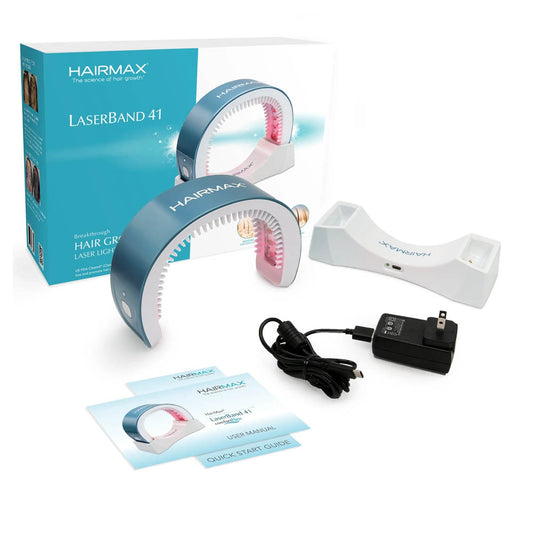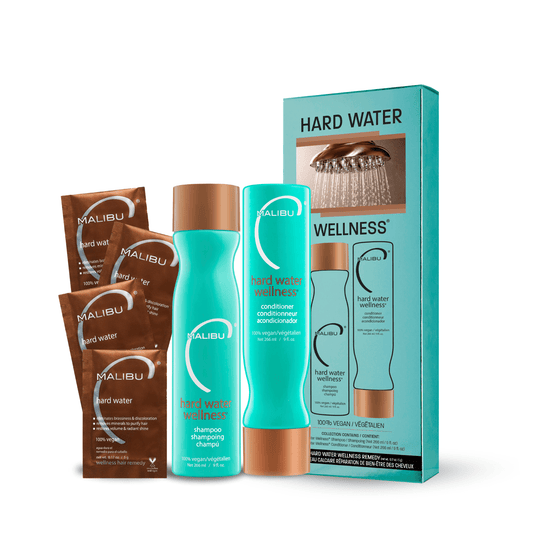
Ladies, how to tell if your hair is thinning...
Share

There are a multitude of reasons why hair becomes thin or worn – everything from our diet, stress levels, medications, even hair styling can affect the overall health of the hair follicles. But there is good news if you need help for thinning hair.
If you are experiencing hair loss or hair shedding, you can take solace in the fact that you are not alone. In fact, approximately 49% of women will be affected by hair loss throughout their lives, with female pattern hair loss (FPHL) being the most common cause of female alopecia. If you want to know more what causes thinning hair in women, and how to treat or manage it? Keep scrolling down!
Female Hair thinning symptoms
Thinning hair in women looks different than thin hair in men. Whereas men tend to lose hair in a horseshoe-shaped pattern starting at the hairline, females experience hair thinning all over the head.
If you are suspecting more hair thinning than usual, you might notice these symptoms:
- Seeing more hair fall out daily either on your brush, on the floor, in shower drain, on your pillows, or in the sink.
- Seeing noticeable patches of thinner or missing hair, including a part on the top of your head that gets wider.
- Seeing scalp through hair
- Having smaller & thinner ponytails.
- Seeing hair break off.
If you’ve got one or more of these symptoms, worry not! Luckily, there are plenty of treatments available to reverse hair thinning & nurse your hair back to health. We will share with you some helpful suggestions and styling techniques to achieve the look of having fuller, thicker hair.
What causes hair thinning in women?
Thinning hair in women can have many different causes. Some of the most common causes of thinning hair in women include:
Genetics

Perhaps, the biggest cause of hair thinning in women is genetics. The most common type of hair loss in women is called female pattern baldness, known medically as alopecia. If one or both of your parents have very thin hair, you’re more prone to experience the same fate hair wise. But don’t despair! There are several treatments available to help manage and even reverse hair thinning when diagnosed early.
Diet

Nutritional deficiencies also contribute to thinning hair in women. Our body requires vitamins and minerals to run all of its necessary processes. When you don’t consume the right amount of nutrients, the body reroutes the nutrients you do eat towards your vital organs and away from your hair follicles. Over time, this can cause very thin hair. Iron, folic acid, and other minerals all help follicles produce hair naturally.
Over-Processing or Styling of Hair

If you wear your hair in braids or tight updos, you may experience a type of thin hair called traction alopecia. Heat styling and chemical processes can damage your hair and cause it to break off, which may result in very thin hair.
Stress

Experiencing chronic stress or events like a major breakup, job loss, death of a loved one or trauma can lead to a disorder called telogen effluvium. Telogen effluvium is a form of hair loss characterized by hair thinning or an increase in hair shedding. It occurs more often in women and is usually triggered by a disturbance to the hair cycle. A person with this condition does not lose all their hair, although it may become noticeably thin. It usually occurs on the top of the scalp. It would be a relief to know that this disorder is generally reversible and is temporary which could last for about 3-6 months.
Pregnancy

Pregnancy is one of the biggest hormonal changes that can happen to a woman. These hormonal changes can cause a myriad of side effects, including changes to hair. Hair is unlikely to fall out during pregnancy. Instead, postpartum hair loss is more likely, with many women experiencing hair shedding after delivery. After delivery, all that hair sheds at once, often in clumps. While it may be quite jarring to see 300 or more hairs shedding each day, it usually resolves on its own without treatment.
Menopause

Menopause is a time of extreme hormonal changes that generally occurs around the late 40s and early 50s. Menopause can lead to the thinning, breakage, or loss of hair for a lot of women. This is mostly due to the consistently low levels of oestrogen and progesterone and an increased production of testosterone. There are a multitude of treatment strategies that can be implemented to aid with improved hair growth and reducing the progression of hair loss. As with many treatments, there is no complete guarantee that hair growth will return to its healthy state however, it can at least be improved.
Dealing with hair loss can be challenging for most women. While hair loss can be upsetting and can induce anxiety, it is usually not a sign of a severe underlying medical disorder, unless accompanied by other symptoms. Improving general and nutritional health may help slow loss. There are cosmetic options, like Toppik Hair Building Fibers, for improving the appearance of hair and medical treatments which, when used long term can improve hair growth.
If you have other symptoms as well as your hair loss, seek the advice of your medical practitioner or a trichologist for a correct diagnosis and a treatment course.



